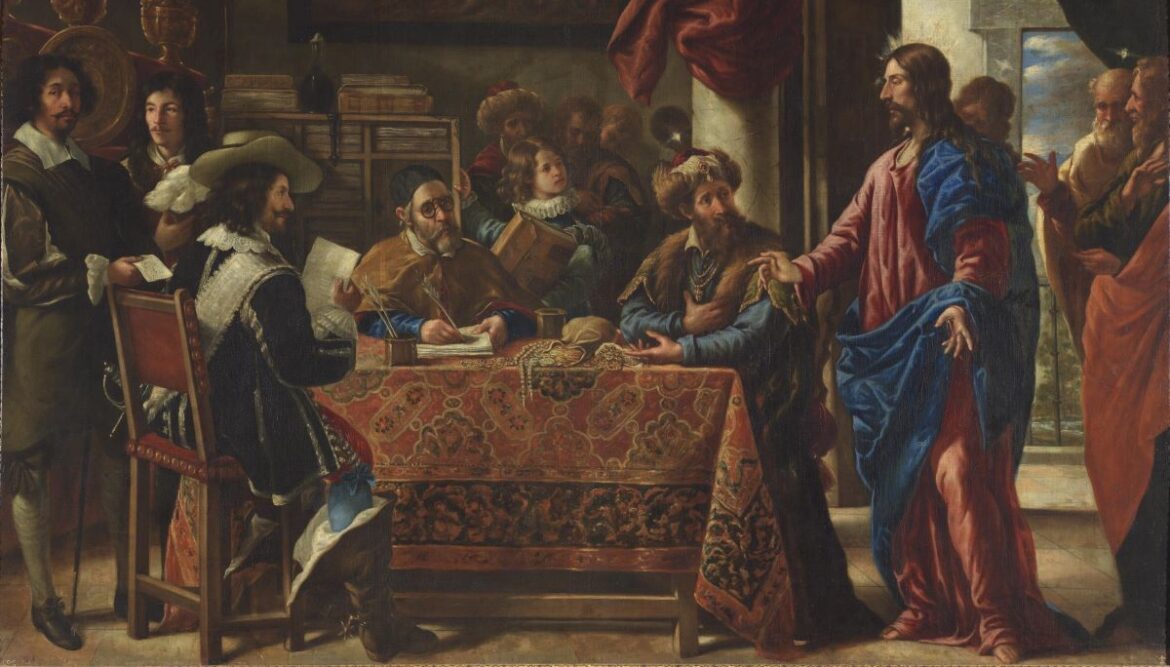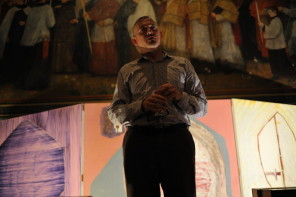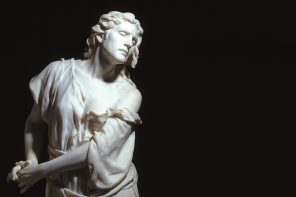Arthur Aghajanian allows a Velázquez portrait to inspire a fascinating exploration of art, truth and contemplative stillness.
“Then it was as if I suddenly saw the secret beauty of their hearts, the depths of their hearts where neither sin nor desire nor self-knowledge can reach, the core of their reality, the person that each one is in God’s eyes. If only they could all see themselves as they really are. If only we could see each other that way all the time. There would be no more war, no more hatred, no more cruelty, no more greed…”[1]
-Thomas Merton
It’s often been said that art reveals truth, though the question of how, or even what we mean by “truth” isn’t obvious. Antonio Palomino y Velasco, a historian of Spanish art, tells us that in 1650 Diego Velázquez was in Rome readying himself to paint the Pope, Innocent X. To prepare, he made a portrait from life of his assistant, a young Afro-Hispanic named Juan de Pareja. When he sent Pareja to show it to some of his friends, they were so amazed they didn’t know whether to address the man or his likeness. It was included in a major exhibition at the Pantheon, Palomino reports, where ‘it received such universal acclaim that in the opinion of all the painters of different nations everything else looked like painting, this alone like [truth].’[2]
So, what is it about this painting—modest in subject and scale — that has captivated so many of us then and now? Palomino’s account, and the spell the portrait still has over us, suggests something deeper than verisimilitude. Those first viewers immediately sensed its inner life, and so do we. In and through the artist’s dashes and daubs of succulent paint, a presence wells up. In the intensity of Pareja’s gaze we are confronted with the truth of being. And though the responses of Velázquez’s time may be exaggerated, the claim that portrait and man seemed indistinguishable is telling. The picture emanates the sacred nature of the subject’s humanity.
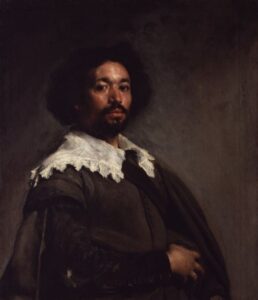 Shown half-length in a standard three-quarter view against a bare, muted ground, Pareja’s humble status is reflected in his simple presentation. His image lacks any of the attributes of royal portraiture, yet demands the attention normally accorded to such pictures. His tousled artist’s clothes, painted in subdued tones, and the small rip on his elbow contrast with his noble countenance and the deep richness of his skin. His complexion has a unique warmth, set off from bushy, pitch black hair, and the delicate strokes of white in a deftly painted collar. His sturdy form seems ready to burst into our space. Looking at us intently, his dark eyes seemingly lit from within, his presence is undeniable. Yet there’s a hint of sorrow in his face. Born to an enslaved Moorish woman and white Spanish man, adversity would have plagued every stage of his life and career.
Shown half-length in a standard three-quarter view against a bare, muted ground, Pareja’s humble status is reflected in his simple presentation. His image lacks any of the attributes of royal portraiture, yet demands the attention normally accorded to such pictures. His tousled artist’s clothes, painted in subdued tones, and the small rip on his elbow contrast with his noble countenance and the deep richness of his skin. His complexion has a unique warmth, set off from bushy, pitch black hair, and the delicate strokes of white in a deftly painted collar. His sturdy form seems ready to burst into our space. Looking at us intently, his dark eyes seemingly lit from within, his presence is undeniable. Yet there’s a hint of sorrow in his face. Born to an enslaved Moorish woman and white Spanish man, adversity would have plagued every stage of his life and career.
Despite their unequal status, the portrait lays bare the absolute truth both men shared. It’s what is ever-present and unchanging. The awareness in which we perceive our interdependence with others. Pareja’s portrait invites a shared sense of being as he returns our gaze. Through art, Velázquez sees his slave anew. Not “according to the flesh” but in the Spirit. In the resulting portrait, we witness the two men connecting. Amid relationship with the other, the creative act unifies artist and sitter. The life roles of master painter and enslaved assistant dissolve in the deeper truth of a shared humanity.
The felt presence of Juan de Pareja through his portrait is something we, and viewers through the ages, have experienced when contemplating the image. It’s a quality in art that isn’t determined by the artist’s intention or will. Art made in communion with its subject takes on its own life. In accessing the Spirit of another through the intimacy of relationship, Velázquez produced an excess of meaning that remade his subject. The effect causes us to become present to ourselves in a new way. We see through the artist’s eyes and sense our response to what he beholds in his subject.
⁎ ⁎ ⁎ ⁎ ⁎
In both the Old and New Testaments, we find numerous examples of renaming.[3] This renaming is also a re-making of the person in the Spirit. And it’s what Velázquez does with Pareja. The man who would become Velázquez’s traveling companion, trusted assistant, and student wouldn’t have been considered a suitable subject to paint. Yet, inspired by personal affection and open to seeing Pareja as a complete person, Velázquez was able to apply his gifts to reimagine Pareja elevated beyond type. A bearer of Spirit equal to any of God’s children.
Diego Velázquez and Juan de Pareja were both painters from Seville. Pareja served in the household and workshop of Velázquez, who granted him freedom in 1650, eight months after the portrait was exhibited. In the Spanish court and urban milieu in which both men eventually circulated, portraiture was a way of immortalizing the elite. With this painting, Velázquez upended conventions. It is thought to be the earliest Spanish portrait of a named Black sitter. The dignified portrayal gives a man with whom Velázquez shared an intimate friendship a visibility denied to Black slaves, and a name as well. In homage to a friend, Velázquez reimagines portraiture beyond the psychological or character study. He uncovers the swirling life beneath appearances. By occupying the privileged space of courtly portrayal, Pareja is fully seen, given agency, and reframed in the light of his true self.
Velázquez had brought Pareja with him to Rome, where he had gone to purchase art for his own master, Philip IV of Spain. An aspiring painter himself, Pareja sought to break from the margins of society into the centre of European culture. Rome was both an art capital and the hub of the Christian world, and in the portrait Pareja appears ready to claim a place in its elite ranks. Away from Madrid and eager to elevate his own name with a great commission, Velázquez may have doubted himself. Would he achieve success in Rome with his painting of the Pope? I can imagine him warmly gazing at his trusted companion and feeling an appreciation for his familiar presence. The picture seems born out of this unselfconscious opening which occurred while both men were joined together far from home. Each striving for success, they saw themselves in one another. Affirming the inner life of his subject, Velázquez possessed the artistic mastery to show us what he experienced as Pareja sat before him.
He painted with assurance, his layered brushwork in stark contrast to the smoothly modelled forms common to Roman portraiture of the time. Though the application of paint seems free, especially in the clothing and right hand, Velázquez exercised great control. Virtuosity isn’t the point. Each stroke of his brush is carefully placed and serves to differentiate and give energy to forms through a mastery of space, colour, and light. His image of Pareja calls us out of the world’s noise, inviting us to slow down and draw in life.
It’s an uncommon experience for most of us, used to living with the visual bombardment of consumer culture. Our mediascape doesn’t encourage reflection. Rather, it forces itself on us. Today our attention is continually dispersed across an endless stream of stimuli, emanating from disparate but interconnected media. Surface effects distract us, and the enchantment of images often encourages falsehoods. Whether “manufacturing consent” or “alternative facts,” a landscape of signs and symbols disorients us. Images made to shape our sense of reality according to the logic of the marketplace create idols, leaving us in a fog. We’re unable to easily distinguish situational truth from the stable, inner truth of our innermost being.
⁎ ⁎ ⁎ ⁎ ⁎
In 1661, Juan de Pareja painted The Calling of Saint Matthew, an ambitious work that includes a full-length self-portrait. How does it reimagine Pareja compared to the Velázquez painting? The latter faces inwardly to the Spirit, while the former faces outwardly to the world. In his own work, Pareja barely resembles the man in Velázquez’s picture. Having been freed to be an artist, he remade himself as one to be admired—one who belongs in the scene. To claim his dignity, he painted himself as a white Christian nobleman. The former slave becomes visible not by emanating the timelessness of the Spirit as Velázquez painted him, but by manipulating his image to claim an elevated position in society.
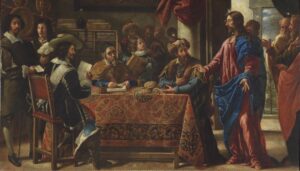
We do the same today using digital technology. Our attachment to social media drives us to continually remake our identity, projecting images of ourselves we hope will appeal to others. Comparing both images of Juan de Pareja, I can’t help but reflect on this impulse. In its awkwardness Pareja’s version of the iconic scene from Matthew 9:9 becomes a mirror for our own insecurities.
As Jesus appears in the tax collector’s office to call on Matthew to follow him, Pareja stands at the far left, looking proudly at the viewer while grasping a piece of paper bearing his signature with the painting’s date—claiming his work. A golden plate sits upright on a shelf partially framing his head like a halo. He concealed his ethnicity by remaking his features and dressing himself to resemble a man of high birth. This act of transformation builds on his gentlemanly portrayal by Velázquez. He’s elegantly attired as a contemporary European, equal in stature to the men immediately surrounding him. Imposing, dignified, and sophisticated, his importance is signified by both his appearance in the biblical narrative and the way he mirrors Christ, who stands across from him. Working on a grand scale, Pareja reimagines himself not in the search for truth, but to make himself visible to those in power for whom the painting was made.
To gain public acceptance as a painter meant also to be seen as a free individual, since slaves couldn’t be recognized as artists. Desperate to leave behind his former identity, Pareja was compelled to paint a convincing image of an impressive setting in which his appearance would also seem true to life. His self-portrait cues us to the structural logic of the entire painting. To demonstrate his skill, Pareja manipulated and pieced together all the elements that were needed to make a monumental religious narrative in the style of the day. But like the traditional still-life, in which the impermanence of the material world was symbolized, the painting’s overabundance of figures, objects, and surface effects evokes the fleeting nature of appearances.
The monumental canvas is crammed with figures in addition to objects of material culture. In the tight, bustling space of a tax office, the artist shows off his skills in composition, anatomy, gesture, light, and texture: a multitude of figural types, a classical column wrapped in a luxurious red curtain, gilded urns, the view of a pastoral landscape in the background. Pareja demonstrates a keen understanding for his craft and puts everything on display for the benefit of the royal audience in whose quarters the painting would eventually hang. Though the work is intended to be convincing, its aspiration likens it to pastiche, reminding me of the synthetic nature of today’s digital media, overwhelming us with spectacle. The picture is encoded. It’s a statement of racial identity made to the imperial powers that granted patronage and status. In an analogous way, our mediascape is a conduit for messages that seek to convince through seductive visual manipulation.
Matthew responded to Christ’s call to be remade as an evangelist. Pareja responded to his master by mimicking the way Velázquez painted himself in Las Meninas (1656). Velázquez’s self-consciousness had to do with his role in the Spanish court. He desired to be seen as an aristocrat as opposed to a mere artisan, which is how painters were regarded in Spain. In Las Meninas, he appears in the act of painting the daughter of King Philip IV and her entourage. Or is it the royal couple dimly reflected in the mirror on the rear wall of his studio? The painter stands partially in shadow. Like in his master’s renowned painting, Pareja stands at the far left of a large, ambitious composition facing us. But in The Calling of Saint Matthew, Pareja seems more concerned with self-image, his transformed figure clearly visible alongside the edge of the picture. For him, it’s not the presence of Christ that matters as much as his own. He seems to be checking to make sure we know he’s there.
Combining contemporary and biblical figures, the image also collapses time in a way that feels contemporary to our world, flattening it like the room in which the narrative unfolds. In its seductive surfaces and piece-meal assembly, the painting signifies Pareja’s adeptness at manufacturing a world according to pictorial formula.
To connect with Velázquez’s portrait requires that we concentrate our attention. We discover the heart of its message in the quiet space of contemplation.
The fashionable dress of the artist and his Spanish companions, and the overall attention given to what seem like costumed actors on a stage are indicative of the false self—costumed, masked, and transient. The image is shot through with the artifice of picture-making, its style and purpose binding it to a specific place and time. It’s connected to our present era in which the digital manipulation of images serves to promote hidden agendas—social, economic, political. Our attention, like that of many of the individuals in the picture, is unstill, diffused, distracted. In drawing our eyes to so many glittering things, the painting causes us to wander, alighting only briefly here or there before moving to the next seductive form.
The present state of our culture inclines me to see a visual kinship in Pareja’s religious narrative, in which busy surfaces clamour for attention. We’ve been conditioned out of spending time with things that are still. To connect with Velázquez’s portrait requires that we concentrate our attention. We discover the heart of its message in the quiet space of contemplation. In the undivided energy found in relationship to another, our true character as love is glimpsed.
Once we’ve reimagined our relationship with others, we begin remaking the world itself in a just way. Pareja’s artistic accomplishment was extraordinary. He emerged from slavery to remake himself as a respected painter at the centre of the Spanish Empire, learning from Velázquez, who called him forth as teacher to student, master to disciple, like Jesus did for Matthew. Elevating the story of others and seeing ourselves in them makes discrimination impossible. Responding to the Spirit in others means seeing and understanding, then acting. Our guiding light is in awareness of the Spirit’s dynamic action as it unfolds in the everyday and overlooked. Our model is Jesus, who bore and shares the Spirit with us. When great works like Juan de Pareja produce a felt sense of the Spirit, it’s appropriate to say they have “life,” or they exhibit truth.
Velázquez’s picture appeals to us with its simple and absorbing stillness, in which the truth, or inner life, of the person fully appears. An embodiment of grace, its execution seems effortless, as though it were painted in one sitting. It centres us in another person. In comparison, our eyes flutter across the illusory surfaces of Pareja’s synthetic world, and we’re encouraged to linger on stylistic devices. The sutures of his laboured construction are apparent just below the picture’s surface. One painting speaks in the language of the absolute, the other to impermanence. We live with both, discernment allowing us to know the difference and why it matters. The truth is always available if we’re willing to be still.
[1] Thomas Merton, Conjectures of a Guilty Bystander (New York: Image, 1966), 155.
[2] Antonio Palomino de Castro y Velasco, “Life of Velázquez,” in Lives of Velázquez, trans. Nina Ayala Mallory (Los Angeles: The J. Paul Getty Museum, 2018), 122. Translation modified.
[3] In Genesis, God changes Abram to Abraham (17:1-5), Sarai to Sarah (17:15-16), and Jacob to Israel (32:24-28). Jesus renames Simon as Peter (John 1:42) and gives the name Boanerges (“sons of thunder”) to both James and John (Mark 3:17).

